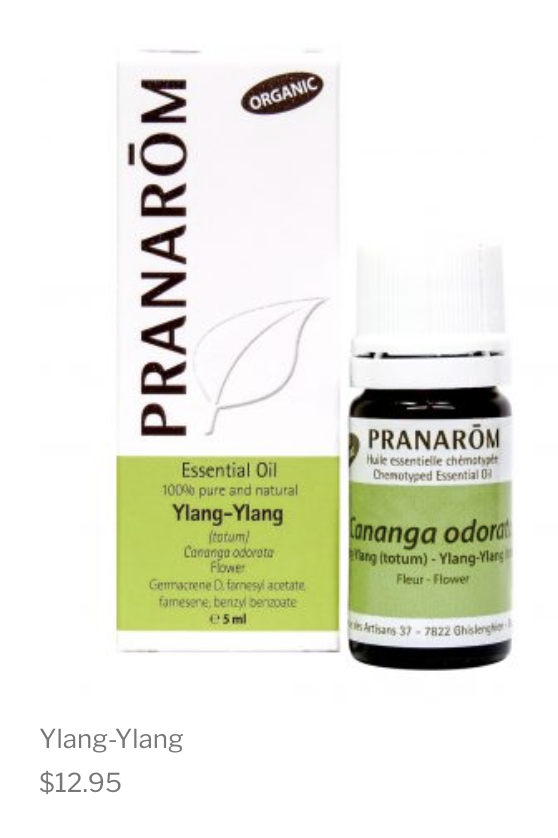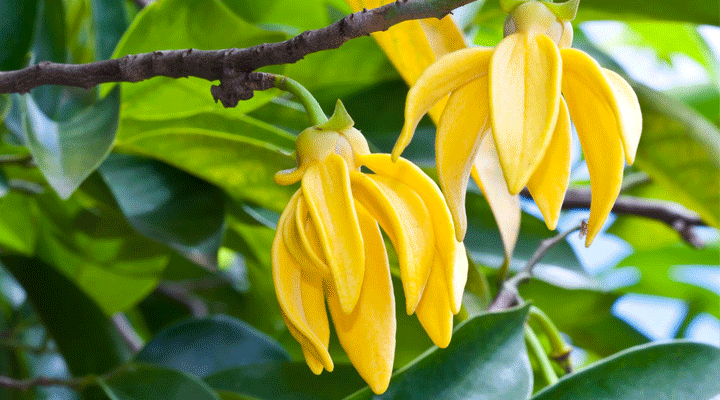Awaken your senses and release tensions with Ylang-ylang
Originally from the Philippines, but very present in Madagascar, particularly on the island of Nosy Be, Ylang-ylang (Cananga odorata) gives an essential oil that combines the pleasure of the senses and therapeutic interest.
The largest consumer of EO in Ylang-ylang is the perfume industry. Coco Chanel has made it popular with its legendary perfume “Bois de îles”, and more discreet notes in the famous Chanel n° 5. Other well-known flavours such as Joy de Patou, Opium by Yves Saint Laurent or Paris by Guerlain also contain notes of Ylang-ylang. Beyond its sweet and sensual fragrance, Ylang-ylang has surprising properties, particularly for the treatment of depression, fatigue (asthenia), contractures or stress. The magic of the benefits of this EO is explained by its extremely complex biochemical composition, the result of a very long and particular distillation.
The Perfume of All Perfumes …
Originally, “Ylang-ylang” meant “flower of flowers” or “fragrance of all flavors”. Its EO releases a warm, round and sensual fragrance, almost heady, very characteristic. The ambient air of l’île de Nosy Be in the northwest of Madagascar already bewitches Ylang Ylang.
 The picking of Ylang-ylang,
The picking of Ylang-ylang,early in the morning
A fast-growing tree that can reach an average height of 30 m, Ylang Ylang Ylang is pruned to maintain its height at man’s height, facilitate harvesting and give more flowers. A conventional plantation has 250 to 350 trees per hectare depending on the topography. Each tree will produce 20-25 kg of flowers per year for 25 years. Flower production takes place all year round. In Nosy Be, the high season starts in March and ends in May. For optimum quality and yield, the flowers are always picked from sunrise to late morning.
Multiple use cases

A relaxing and deep massage
with Ylang always relaxes.
Scientific aromatherapy professionals consider Ylang-ylang EO to be very useful in the fight against inflammation, pain and contractures, but also stress, insomnia and sadness
In dermo-cosmetics, it is also used as a hair tonic in the fight against hair loss.
During a wellness massage, Ylang-ylang is excellent for a nervous rebalancing.
In olfactotherapy, Ylang-ylang essential oil is breathed to sharpen the senses and to temper sadness, fear, anger and jealousy among others. Its warm and sensual fragrance can also have aphrodisiac and sexual tonic effects. In Indonesia, tradition has it that flowers are spread on the bride’s bed as an invitation to the pleasure of the wedding.
A Very Complex Aromatic Profile
It is its very rich biochemical profile that gives the essential oil of Ylang-ylang all these virtues, and in particular the presence of important terpene esters (linalyl acetate and linalyl benzoate). It is also necessary to know which “fraction” of Ylang-ylang we are talking about. Indeed, the distilled plant delivers its essence in several distinct stages, called fractions.
The perfume industry, a major consumer of Ylang-ylang, can choose to use only one or the other fraction, for reasons of budget or fragrance. For example, Ylang-ylang extra is actually a fraction of EO. On the other hand, Ylang-ylang’s “totum” or “total” EO, preferred by aromatherapists, is the precious synergy of all distilled fractions, one after the other.

Different densities for the various
fractions of the ylang-ylang
Multiple Components
- Linalool and geraniol give the EO fresh, floral and lemon notes at the same time. Other terpenic alcohols are also present and round off the fragrance.
- Paracresyl methyl ether gives a slightly medicinal odour to the first fractions of EO and Extra, a particular fraction at the beginning of distillation, which is difficult to obtain. It is probably this note that makes the ylang ylang ylang EO difficult or not appreciated by some, while it is addictive for others.
- Sesquiterpenes, such as germacrène-D and farnesene, bring both woody and floral notes. These are greener notes.
- Caryophyllene and cadinene give a spicy, more peppery note.
- Geranyl acetate and benzyl acetate, important esters in the composition, are the only ones responsible for the characteristic jasmine note emanating from the ylang ylang ylang EO. It is also partly these esters that give EO soothing and anti-inflammatory properties to a certain extent. However, not all fractions of EH contain it in the same proportions. This jasmine note is a valuable factor for those who love ylang ylang ylang or just as unpleasant for others.
- Methyl benzoate, another terpene ester, is one of the main elements of fractions 1 and 2 of ylang ylang (about 10%). This element gives a carnation note to the EO.
- The terpene aldehydes present in the EO give it a very strong olfactory power, especially in diffusion.
- Phenols are also present at a very low level, but in all fractions. P-cresol, eugenol or iso-eugenol give the essence a touch of warmth, with spicy and balsamic notes.
An Expert Distillation
Ylang-ylang EO is obtained by distilling the fresh flowers of the “Cananga odorata” tree. The essential oil is collected in 5 successive fractions during a distillation that can last from 10 to 20 hours.
The fractions S Extra (S=superior), Extra, First, Second and Third are distinguished. The different fractions are determined according to their density, which is specific to each.

One hundred kilos of fresh flowers
will give between 2 and 2.5 kilos
of essential oils.
First, the flowers are placed in a preheated stainless steel cooper. One hundred kilos of fresh flowers will give between 2 and 2.5 kilos of essential oil.
From the beginning of distillation, a large amount of energy is required to obtain the S Extra and Extra fractions thanks to the very hot steam. If the heating is not strong enough, we will immediately obtain the first fraction of Ylang-ylang instead of the extra grades, which would be a pity. This implies that a lot of firewood is needed for a good distillation, and it is not always easy in Madagascar to find it for the smallest producers.
After about an hour of distillation, the distiller reduces the intensity of the fire and can let branches and logs the size of an arm burn. The first and second fractions can then be extracted.
After about 6 hours of distillation, a less odorous fraction is obtained, the third. However, this fraction is important for the final product if we want a “totum” (mixture of all fractions). This is why the distillation takes more than 10 hours.
The essential oil of ylang ylang ylang is collected throughout the distillation process, each time the decanter contains 125 ml of oil. The 5 fractions are therefore actually harvested in 20 to 30 times. You said complicated?
A Very Complete Essential Oil
The essential oil of Ylang-ylang Totale or “Totum” is the favorite of aromatherapists. Its medicinal properties are superior to those of isolated fractions since all the aromatic molecules of the plant are present.
This essential oil is a precious material, and therefore very often unfortunately subject to FRAUD! The falsification of Ylang oil is quite frequent, because the law of profit reigns supreme. The main means of falsification are:
- The addition of an essential oil of “rupture” to increase the volume (a mineral oil, a vegetable oil, an essential oil…). It’s quite coarse and easily detectable but quite common.
- The addition of coconut oil. It is also quite easily detectable during chromatography such as those performed by Pranarom.
- Heating the third fraction of Ylang-ylang mixed with a little extra grade or first fraction.
- Only a few players in the production of Ylang-ylang can give their customers any guarantee as to the traceability and quality of their product. This is of course the case for producers and distillers who have been working with Pranarom for so many years in Madagascar.


